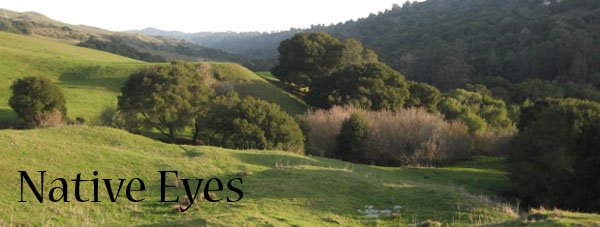
Native Eyes met at Gazos Beach, where the coyotes treated us to a tangle of trails. We found multiple trails braiding together and lots of urine marking sites concentrated at the mouth of a small dry creek. The urine spots became fewer and further between, the further we went up or down the beach. What does that pattern say about the coyote's territory and borders?

Our heads full of questions and our journals full of sketches, we returned to camp. We rock-boiled a big pot of vegetable soup for dinner. We heated some large round stones (not from a creek within the last year) to glowing by building a fire on top of them, pulled them out with some sticks, and plopped them in the soup. I wanted to dip them in water before putting them in soup, just to rinse off the ash, but we decided that was more effort than it was worth. The soup cooked faster than it ever would have on a stovetop.

The next morning we went south to a coastal meadow for our bird sit. When we got there the little birds were huddled in their bushes, twittering to one another. They grew quieter as we sat, and a flicker made it's rounds on the tallest trees, calling "clear!" Robins sat high and alarmed, and a mob of crows called raucously. Scrub-jays called in clumps, "jay? Jay? Jay?" The meadow went quiet a few times as well. Right before we ended, the little brown birds decided to come out and feed, and the meadow was full of little flutters. Then they all ditched it again, and one of our group saw a hawk with short wings and a long tail glide low over the meadow.

When we mapped out the sit, many of us could recognize the patterns. Our story went like this: The birds were tense and huddled in hiding because a hunting cooper's hawk was in the area. The flicker and robin called as it came nearer, and then all went silent. When that hawk left, the little birds jumped on the chance to feed, just before a second hawk (or perhaps the same hawk, having doubled back) made an entrance.

After we mapped and debriefed, we went out to an old burn site, where the land was sand and many tracks crisscrossed through the brush. Our goal was to trail deer, but quite soon into our expedition this track reached out and grabbed our attention. There were lots of deer tracks, as well as lots of human and dog tracks. This one, though, struck us as a classic cougar print.

We trailed the cougar, finding tracks here and there where they had been spared by hiker's feet, and came upon the above. There were plenty of dog tracks around to confuse matters. What was this animal doing when it made this track? Is it a dog, or a cougar moving at high speed? We drew many of the cougar tracks, took measurements, and played with different styles of sketching. Have you ever tried drawing a track life-sized?

The trail eventually led us to this scrape. The scat under the debris was bobcat sized and shaped, but the scrape was far larger. We had not seen any bobcat tracks, either. And the scat was fresh, soft, dark red-brown, smelling of meat and cat turd, and had very little, but still some, deer hair content. Why did the cat mark this area? Why does the scat have so little hair in it? Why is the scat so small?

We took our photos and our sketches and returned to camp for the night. We fleshed some rabbit hides in preparation for a future activity, then shared food and stories around the fire.










